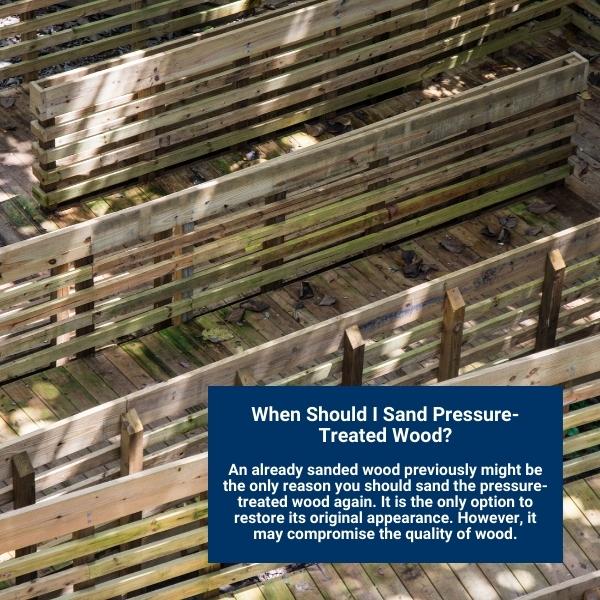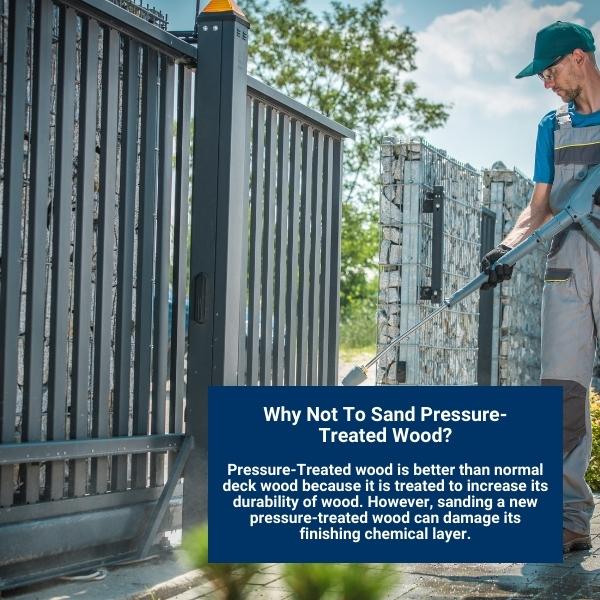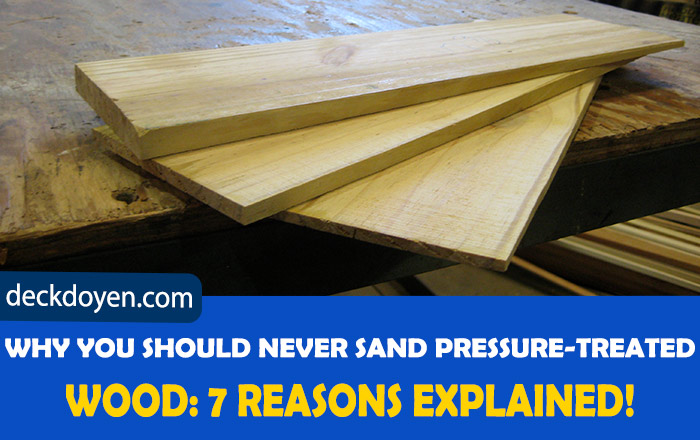You might be planning to sand your deck wood before re-staining because you read it somewhere. However, not all woods are benefited from sanding. You can harm the pressure-treated woods if you sand them. But what might be the reasons never to sand your pressure-treated wood?
Pressure-treated wood has a special coating that makes it durable and protects it from environmental damage and fungal growth. Therefore, sanding pressure-treated wood causes harm to its texture and water resistance. Additionally, it makes dark and light patches on wood.
Sanding pressure-treated wood does more harm than good. Neither it makes your deck look good, nor does it make it last longer. So here is the list of reasons that indicate that sanding pressure-treated wood is a bad idea.
7 Reasons You Should Never Sand Pressure-Treated Wood:
It’s about how long the pressure-treated would last and look great for its entire lifespan. The answer is that sanding would heighten other pressure-treated wood issues, so you must understand proper upkeep and potential consequences.
The following 7 reasons will convince you not to sand pressure-treated wood ever:
1. Imbalance Color Appearance:
A pressure-treated deck can’t look good after sanding. Sanding can leave dark and light patches that cannot be covered by repainting. Only sanding with the hands of an expert can bring out even results. However, it can look appealing only if you balance it after numerous sanding cycles over the darker regions to try to even them out.

Moreover, the lighter portions of the wood will appear to have been sanded more than the rest. You have no idea how the wood will appear after being sanded, so the risk is not worth it. You should be able to enjoy your deck after putting time, effort, and money into it; therefore, it’s better to avoid sanding pressure-treated wood.
2. Irreparable:
The bad news is that your deck will never look like it did when you first acquired it or when you purchased it brand new once you sand it. If you’re reading this article after sanding your pressure-treated wood, then you must know that it’s irreversible. There is no way to restore the original finish once pressure-treated hardwood has been sanded through its chemical coating, which is normally brown but occasionally has a greenish tint. The best way is to sand more extensively to eliminate all the coatings if your pressure-treated lumber seems patchy after being sanded.
Also Read: Best Temperature Ranges For Staining Deck
Although it appears to be a straightforward method, some chemical coatings penetrate completely through the wood, especially around knots where the pores are wider, and the chemicals can flow through. The end consequence will be more unpredictably two-toned wood that will increase dissatisfaction with the outcome of your job.
3. Unpredictable Quality Appearance:
Quality can vary like goods. Not every pressure-treated lumber will have the same after-sanding appearance as the pictures in this article. You can’t anticipate the results because you don’t know what brand it is. You can’t even guess the quality of the deck.

The only results with most pressure-treated wood are likely to be drying out, twisting, cracking, and the knots splitting and sticking out, giving your kids/pets slivers when they play if you sand it. Remember that pressure-treated wood will never look brand-new after sanding the chemical coating. It’s simply ineffective to take the risk of sandpaper pressure-treated wood from the beginning, regardless of quality.
4. Health Hazards:
The potential health effects of sanding pressure-treated wood are the most obvious reason to avoid doing so. It doesn’t take a chemist to comprehend you shouldn’t be in direct contact with these substances. You might be oblivious about the types of chemicals the wood is drenched in.
Whether your wood has been professionally treated, you should use protective coverings like a dust mask, safety glasses and gloves. You have no idea how well these chemicals affect your skin over time, even. I wouldn’t advise homeowners or contractors to sand pressure-treated wood if you don’t like the odor for yourself or your crew.
Also Read: Oil Vs Water-Based Deck Stain: Which Is Better And Why?
5. No Promising Result:
A common scenario is re-staining a pressure-treated deck that had formerly been dyed with a thick, impenetrable, or solid stain. It is a typical problem for people who buy a new house and get a pressure-treated deck sanded by previous owners. Sanding might be the only option to restore its original appearance and maintain it.

Another situation involves “accidentally” sanding pressure-treated wood, which implies that you did not know what kind of wood you were sanding. Even an expert may find it difficult to identify the type of wood after staining, particularly if the stain is dense or translucent. So, sanding can usually do more harm than good.
Also Read: When To Stain A New Cedar Deck? Best Ideal Time Revealed!
6. Affects Durability:
Pressure-Treated wood is better than normal deck wood because it is treated to increase its durability of wood. However, sanding a new pressure-treated wood can damage its finishing chemical layer. You may also accidentally over sand it resulting in removing the chemical coating. Thus, sanding reduces the durability of your deck, and it doesn’t last long.
7. Impacts Wood Quality:
Sanding a pressure-treated wood badly affects the quality of the wood. The chemicals penetrate the wood pores and cover them from external moisture, algae, and mold growth. Sanding scrapes off these chemicals, destroying the layer at random spaces. It results in cracking and algae and mold growth because moisture leaks into the surface of the wood. Therefore, it’s best to avoid sanding.

Final Words:
Sanding has many negative impacts; it destroys appearance, quality, durability, and health. So, never sand it, even if it’s old. I hope you find this article resourceful research and take proper measures before beginning any sanding.
FAQs:
What Are The Health Hazards Of Sanding Pressure-Treated Wood?
Arsenic is released as smoke, ash, or sawdust when pressure-treated wood is sanded or sawed. The Guidelines suggest never burning treated wood. Additionally, sand and saw outdoors where there is sufficient ventilation.
How Can You Maintain Pressure-Treated Wood Looking Its Best All The Time?
To keep the natural color of pressure-treated wood for as long as possible, you should wipe it regularly and apply a water-repellent finish with an ultraviolet stabilizer. The stabilizer will not only inhibit discoloration but also slow it down.

